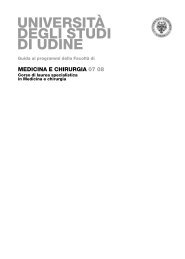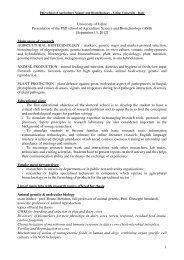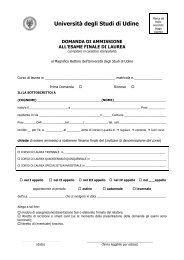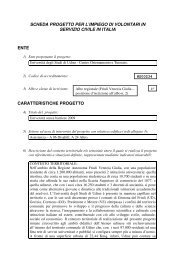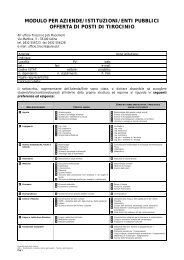â¢GUIDA ECONOMIA 07-08 - Università degli studi di Udine
â¢GUIDA ECONOMIA 07-08 - Università degli studi di Udine
â¢GUIDA ECONOMIA 07-08 - Università degli studi di Udine
You also want an ePaper? Increase the reach of your titles
YUMPU automatically turns print PDFs into web optimized ePapers that Google loves.
252 prospectus pordenone<br />
Second volume: Le società. The whole volume<br />
must be <strong>stu<strong>di</strong></strong>ed; no parts are excluded.<br />
Students should study the manual and an<br />
updated version of the Italian Civil Code.<br />
Knowledge of the company law reform<br />
(2003) and subsequent amendments is a<br />
pre-requisite. The manual has been<br />
updated to comply with Legislative<br />
Decree 310/04.<br />
Students owning to the old degree system<br />
shall have to sit the ‘Commercial Law 1’<br />
exam with the following supplementary<br />
material:<br />
- G.F. CAMPOBASSO, Diritto commerciale,<br />
third volume, Contratti, titoli <strong>di</strong> cre<strong>di</strong>to,<br />
procedure concorsuali, latest e<strong>di</strong>tion (only<br />
the section regar<strong>di</strong>ng insolvency procedures).<br />
Students should be familiar with<br />
the amendments to bankruptcy Law<br />
80/2005 and with Legislative Decree<br />
347/03 and subsequent amendments<br />
regar<strong>di</strong>ng material insolvencies ‘situazioni<br />
<strong>di</strong> crisi particolarmente rilevanti’.<br />
Exams<br />
Since 1 January 2006 (for exams referring to<br />
sessions prior to this date, the old terms and<br />
con<strong>di</strong>tions and programs apply)<br />
The exam is written and includes three<br />
topics (no multiple choice questions).<br />
The last question is made up of two parts:<br />
one for students studying under the old<br />
degree system (Vecchio or<strong>di</strong>namento)<br />
(section on insolvency) and one for students<br />
studying under the new system<br />
(Nuovo or<strong>di</strong>namento). Students are given<br />
30 minutes to answer. In cases which are<br />
not straightforward, a supplementary oral<br />
examination may be required. The correction<br />
and marking of the papers, the<br />
possible supplementary oral examination<br />
and the registration of the exam will take<br />
place imme<strong>di</strong>ately after the written exam,<br />
except if there are a large number of can<strong>di</strong>dates.<br />
Marks can only be registered on<br />
the same day as the exam. Should it is not<br />
be possible to correct and mark the<br />
papers imme<strong>di</strong>ately after the written<br />
exam, another day and time will be<br />
arranged for exam registration and possible<br />
oral exam. Students must come for<br />
registration in person. Students who have<br />
passed the written examination but who<br />
fail to turn up for registration and the<br />
possible supplementary oral exam, will<br />
have to re-sit the written examination.<br />
CORPORATE FINANCE<br />
Prof. Gabriele Toniolo<br />
Aims<br />
The purpose of the course is to provide<br />
the students with the principles and basic<br />
skills for the comprehension of corporate<br />
finance. To this end, the program is comprised<br />
of three parts which aim respectively<br />
to explain the <strong>di</strong>fferences between<br />
an accounting and a financial approach,<br />
to develop the skill required to <strong>di</strong>agnose<br />
corporate situations and perspectives and<br />
to select the best criteria for financial<br />
decisions.<br />
Contents<br />
Valuing investment projects<br />
Net present value (NPV).<br />
Other criteria for investment decisions.<br />
Invested capital.<br />
Cash flows.<br />
Discount rate.<br />
Cash flow determination.<br />
Valuing corporations<br />
Flow-based approach: income method.<br />
From accounting income to flows of<br />
income.<br />
Prospective incomes.<br />
Financial method and possible approaches.<br />
Analysis of management areas.<br />
Financial and fixed asset management<br />
analysis.<br />
Economic management analysis.<br />
Firm equilibrium.<br />
Flow-based analysis.




